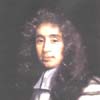
| Judge Jeffreys
George Jeffreys, 1st Baron Jeffreys Bt (May 15, 1645 – April 18, 1689), better known as "The Hanging Judge", became notorious during the reign of King James II, rising to the position of Lord Chancellor (and serving as Lord High Steward in certain instances).
Jeffreys was born at the family estate of Acton Hall, Wrexham in Wales, the sixth son of John and Margaret Jeffreys. He was educated at Shrewsbury School; St Paul's School, London and Westminster School, London. He became an undergraduate at Cambridge University, leaving after one year and he embarked on a legal career in 1668. Shortly afterwards, he wormed his way into the favour of the Duke of York, younger brother of Charles II of England, who would succeed Charles as James II of England. This development in Jeffreys's career indicates his ambition, since he had been brought up a strict Protestant, and James was a Catholic. Jeffreys was knighted in 1677 and by 1680 had become chief justice of Chester. Charles II created him a baronet in 1681, and two years later, he was Chief Justice of the King's Bench. His subsequent career showed how willing he was to subordinate his impartiality as a judge to his political ambitions.
One of several trials which showed how far Jeffreys was prepared to go in order to curry royal favour was that of Algernon Sidney, who had been implicated in the Rye House Plot and was convicted on the flimsiest evidence and executed. James II, following his accession to the throne, elevated Jeffreys to the peerage as Baron Jeffreys.
His reputation as a judge became even more unsavoury following the sentences he handed out to followers of the Duke of Monmouth, an episode that concluded the Monmouth Rebellion, which became known as the "Bloody Assizes." James named him Lord Chancellor in 1685, and he held this position until James was deposed in 1688. Recognizing what the new reign would mean for him, he attempted to flee the country but was captured and died, unlamented, in the Tower of London. He was buried in St Mary Aldermanbury.
|






